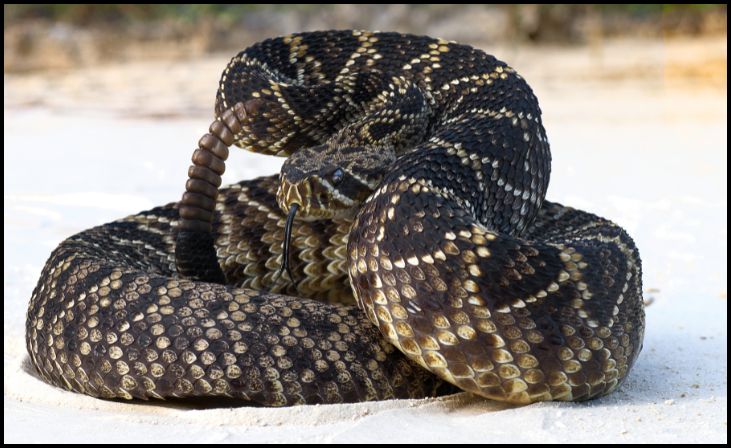Rattlesnakes are fascinating creatures, known for their distinctive rattling tails and potent venom. North America is home to several species of rattlesnakes, each unique in its own way. Among them, the largest species are particularly impressive, both in size and presence. In this article, we will explore the seven largest rattlesnake species found in North America.
Timber/Canebrake Rattlesnake

The timber rattlesnake (Crotalus horridus) is a formidable species found in the eastern United States. Known for their passive and slow-moving nature, timber rattlesnakes can grow quite large, typically reaching lengths of 3 to 5 feet. They are distinguished by their robust bodies and distinctive color patterns, which vary from yellow to black. Historically, they were classified into two subspecies: the timber rattlesnake and the canebrake rattlesnake. These snakes prefer deciduous forests, rugged terrain, and remote, undisturbed areas.
Eastern Diamondback Rattlesnake
The eastern diamondback rattlesnake (Crotalus adamanteus) holds the title for being the largest and most heavily bodied rattlesnake in the United States. Averaging about 5 feet in length, these snakes can sometimes grow up to 8 feet, making them true giants among rattlesnakes. Their distinctive diamond pattern, which gives them their name, is a key identifying feature. Eastern diamondbacks are native to the southeastern United States, inhabiting pine forests, coastal scrubs, and flatwoods.
Western Diamondback Rattlesnake
The western diamondback rattlesnake (Crotalus atrox) is the longest rattlesnake species in the United States, with the largest recorded individual measuring 8.5 feet. On average, these snakes range from 3.5 to 4.5 feet. They are characterized by their distinctive diamond patterns and the contrasting black and white banding on their tails. Western diamondbacks are widespread, found in various habitats from the southwestern United States to northern Mexico, including deserts, grasslands, and scrublands.
Mojave Rattlesnake
The Mojave rattlesnake (Crotalus scutulatus) is renowned not only for its size but also for its potent venom. Found in the southwestern United States, from California to Texas, Mojave rattlesnakes typically measure between 3 to 4 feet in length. They exhibit varied color patterns, often influenced by their specific habitat. What sets them apart is the variability in their venom composition, with some populations possessing neurotoxic venom that can be more dangerous than the hemotoxic venom of other rattlesnake species.
Western Rattlesnakes

The term “western rattlesnakes” encompasses several subspecies, including the southern Pacific rattlesnake (Crotalus oreganus helleri), the northern Pacific rattlesnake (Crotalus oreganus oreganus), the Grand Canyon rattlesnake (Crotalus oreganus abyssus), and the midget faded rattlesnake (Crotalus oreganus concolor). These rattlesnakes vary in size, typically ranging from 2 to 4 feet. Their adaptability allows them to thrive in diverse habitats, from deserts to forests, across the western United States.
Pygmy Rattlesnakes
Pygmy rattlesnakes (Sistrurus miliarius) may be smaller in size compared to other species on this list, but they are still notable. Ranging from the southeastern U.S. to eastern Texas, pygmy rattlesnakes usually measure between 1 to 2 feet in length. They inhabit a variety of environments, including pinewoods, hardwoods, and areas adjacent to marshes. Despite their smaller size, they possess a potent venom and a distinctive, high-pitched rattle.
Eastern Massasauga
The eastern massasauga (Sistrurus catenatus catenatus) is a small, thick-bodied rattlesnake found in shallow wetlands across parts of the United States and Canada. Typically, they reach lengths of 2 to 3 feet. Eastern massasaugas display a dorsal pattern of black or very dark brown oval-shaped blotches on a gray or reddish-brown background. Their preferred habitats include swamps, marshes, and other wetland areas, where they can often be found basking on logs or rocks.




